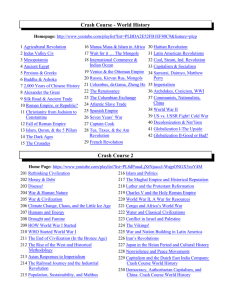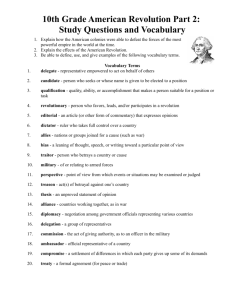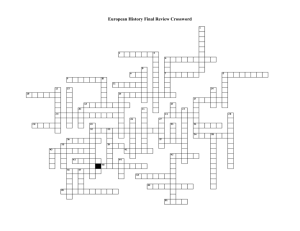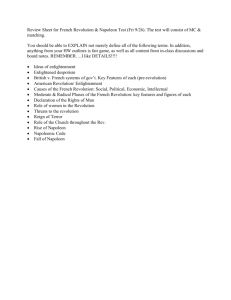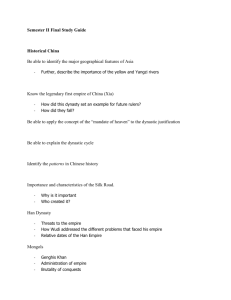Learning Targets - St. Francis School District
advertisement
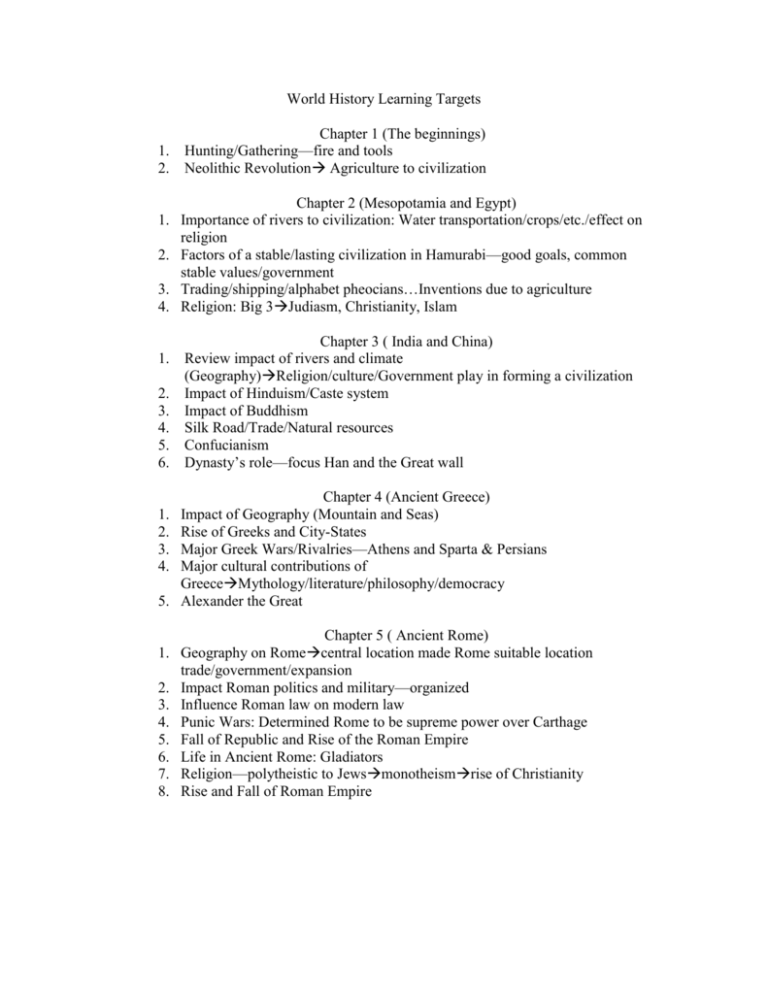
World History Learning Targets 1. 2. Chapter 1 (The beginnings) Hunting/Gathering—fire and tools Neolithic Revolution Agriculture to civilization Chapter 2 (Mesopotamia and Egypt) 1. Importance of rivers to civilization: Water transportation/crops/etc./effect on religion 2. Factors of a stable/lasting civilization in Hamurabi—good goals, common stable values/government 3. Trading/shipping/alphabet pheocians…Inventions due to agriculture 4. Religion: Big 3Judiasm, Christianity, Islam 1. 2. 3. 4. 5. 6. Chapter 3 ( India and China) Review impact of rivers and climate (Geography)Religion/culture/Government play in forming a civilization Impact of Hinduism/Caste system Impact of Buddhism Silk Road/Trade/Natural resources Confucianism Dynasty’s role—focus Han and the Great wall Chapter 4 (Ancient Greece) Impact of Geography (Mountain and Seas) Rise of Greeks and City-States Major Greek Wars/Rivalries—Athens and Sparta & Persians Major cultural contributions of GreeceMythology/literature/philosophy/democracy 5. Alexander the Great 1. 2. 3. 4. 1. 2. 3. 4. 5. 6. 7. 8. Chapter 5 ( Ancient Rome) Geography on Romecentral location made Rome suitable location trade/government/expansion Impact Roman politics and military—organized Influence Roman law on modern law Punic Wars: Determined Rome to be supreme power over Carthage Fall of Republic and Rise of the Roman Empire Life in Ancient Rome: Gladiators Religion—polytheistic to Jewsmonotheismrise of Christianity Rise and Fall of Roman Empire Chapter 6 (The World of Islam) 1. Impact/life of Muhammad Revisit the Islam religion 2. Arab conquestsHow spread Islam spread rapidlyImpact of the Battle of Tours 3. Impact of Geography/trade allowed growth of urban and rural areas 4. How Islam culture contributed to advancements for the world in philosophy, science, and history Chapter 7 (Early African Civilizations) 1. Impact of Geography: How climate zones influenced history and culture 2. The control of trade routes was a source of power for African Kingdoms 3. Identify some key elements to early African culturecommon ancestors, importance of family, community education…etc-Activity incorporate culture using oral tradition 1. 2. 3. 4. 5. 6. 7. 8. 9. 1. 2. 3. 4. 5. 1. 2. 3. 4. 5. Chapter 8 (The Asian World) Briefly mention the fall of the Han caused a long period of division and chaos in China Chinese government-Civil servicealso talk about Marco Polo The Rise of the Mongols under Genghis KhanHeight of Mongols under Kublai Khan Mongol societyreligion/government/culture Geography leads to more seclusion Japan’s division in leadership to Feudal JapanShogun/Samurai Shinto religion/life in early Japan Islam influencing India Map of Southeast Asia and briefly talk about Life in Southeast Asia Chapter 9 (Emerging Europe and the Byzantine Empire) Explain the transition from a centralized empire to fragmented Kingdoms to Feudalism Describe the system of Feudalism Compare and Contrast Kingdom of England/France/Holy Roman Empire in the Middle Ages Explain the connection between the Byzantine Empire and the Roman Empire Explain why Christians engaged in the crusades Chapter 10 (Europe in the Middle Ages) Advances in farmingdaily life of a peasant Identify the political power of the ChurchInquisition Culture/education in the Middle Agesforming universities/literature The Death and upheaval Black Plague/Decline of Church/Hundred Years’ War Political recoveryrise of the Monarchy Chapter 11 (The Americas) 1. Compare and Contrast the different groups in the Americas 2. MesoamericaCompare and Contrast Olmec/Maya/Aztec/Inca Chapter 12 (Renaissance and Reformation) 1. Italian city-states that were the center of Italian political, economic, and social lifewhy did it start there? 2. Renaissance SocietyNobility, peasants, townspeople, Machiavelli Power 3. The Revival of arts and ideashumanism, literature, education, art 4. The Division of Catholism/origin of LuthernismMartin Luther 5. Spread of ProtestantismDifferent factions evolve/break of England 6. Catholic Reformation Chapter 13 (The Age of Exploration) 1. Exploration by the explorers of this time period 2. Spain and Portugal set up empires and profited from the resources and trade of their colonies 1. 2. 3. 4. Chapter 14 (Crisis and Absolutism in Europe) Identify the causes of conflict between Catholics and Protestants Explain the impact of religious wars on Europe Analyze the pros and cons of despotism Provide some examples of European culture in the 1600-1700’s Chapter 15 (The Muslim Empires) 1. The expansion of the Ottoman Empirecause and effectsculture and religion 2. Rise Moguls and Decline of Mogulsleads to colonization by British Chapter 16 (The East Asian World) 1. China meets the West: China isolated itself/fell behind in technologyleads to European interferencespice trade in South East Asia 2. Japan becomes unified under Tokugawabrief European contactremained isolated Chapter 17 (Revolution and Enlightenment) 1. Identify the main ideas of the scientific revolution 2. Explain the shift in thought process that developed from the Middle Ages to the Enlightenment periodcultural/political/religious/ 3. Understand the connection between the Enlightenment and the American Revolution 1. 2. 3. 4. 5. Chapter 18 (The French Revolution and Napoleon) List and describe the main causes leading to the French Revolution in 1789Three Estates/Financial crisis/American Revolution/Estates-General Identify and explain the shift in the Revolution to violent radicalism1st RepublicReign of TerrorRise of the Revolutionary powerThe DirectoryNapoleon Identify the factors that enabled Napoleon to rise to power Describe the domestic contributions made by Napoleon Identify the factors that led to the fall of Napoleon and his empire Chapter 19 (Industrialization and Nationalism) Describe the factors that allowed the industrial revolution in Britain. Identify the impact of the industrial revolution Identify the congress of Vienna List and describe examples of revolution in Europe Explain how nationalism led to the unification of Germany and Italyand how it effected the other European nationsFrance/AustriaHungary/Russia/United States 6. Examine Great Britain’s stability and rise to World Empire during this period 7. Discuss new scientific advancementPasteur and Darwin 1. 2. 3. 4. 5. Chapter 20 (Mass Society and Democracy) 1. Examine the Rise of the Global economyinventions/assembly line/factories/working class/Marx’s Theory/Unions form 2. Identify how the Industrialization led to changes in societyurban growth/improvements in health and sanitation/corporate elite, middle-class, urban class/ changes with women in society/advancements in education/importance of leisure time/ 3. Analyze the connection between industrialization and the rise of democracythe growing prosperity 4. Identify the national rivalries in the late 1800s early 1900s 5. Examine the influence of scienceMarie Curie/Einstein/Freud 6. Define Social Darwinism/Anti-Semitism/Zionism Chapter 21 (The Height of Imperialism) 1. Explain how industrialization led to European Imperialism during the late 1800s and early 1900snew resources/markets/military power to defend economy/compete with rival nations 2. Analyze the effects of Imperialism on Native peoples 3. Analyze the political and economic structure of Latin AmericaRevolt in Mexico/Revolt in South America/Caudillos Chapter 22 (East Asia Under Challenge) 1. Define and identify the spheres of influence in China 2. Identify the factors leading up to the rise of Modern Japan 1. 2. 3. 4. 5. Chapter 23 (War and Revolution World War I) Identify both short-term and long-term causes of World War I. Explain why there was a stale-mate on the Western front of World War I. Explain how the Russian Revolution led to the end of the Eastern front. Analyze the impact of the United States entry into World War I. Analyze the Treaty of Versailles Chapter 24 (The West Between the Wars) 1. Identify the causes and effects of the Great Depressionhow did it effect various countries/rise of dictators 2. Describe communism in the early part of the Soviet Union. 3. Analyze the Spanish Civil War 4. Identify the factors that contributed to the rise of Hitler and Nazi Germany 5. Identify the influences of propaganda on mass societies Chapter 25 (Nationalism Around the World) 1. Identify the tensions between the Arabs and JewsBalfour Declaration/Zionist movement/problem of Palestine 2. Describe the military build up of Japan Chapter 26 (World War II) List the steps that Hitler took to provoke/test the rest of Europe. List the steps that the Japanese took to provoke/test the United States Analyze the initial success of Germany and Japan during World War II. Describe the reasons the Allies became successful against Germany and Japan and eventually were victorious. 5. Identify the horrors faced by people who were sent to Nazi concentration camps 6. Describe the impact war has on the civilian population 1. 2. 3. 4.
